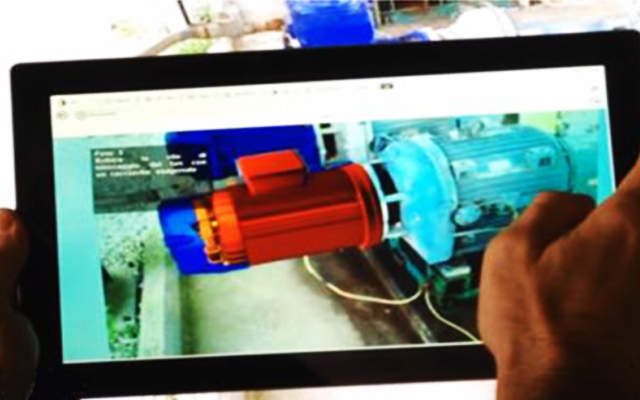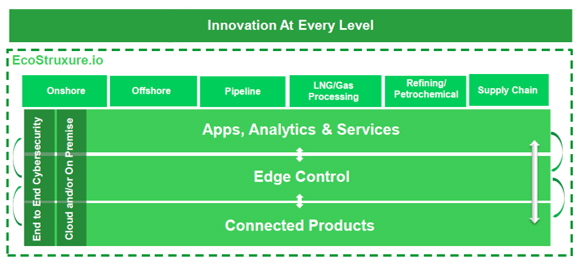Authors: Maurizio Rovaglio, Vice President, Oil & Gas Technology and Alliances, Schneider Electric, and Jack Creamer, Market Segment Manager, Pumping Equipment–Industry Business, Schneider Electric
IIoT technologies are introducing new possibilities for extracting more value from existing systems. These OT systems can now be converged with popular, standardized IT systems. In addition, large-scale analytics techniques derived from non-industrial applications such as finance, workforce management, and healthcare, are being applied to Oil & Gas industry scenarios and are creating new ways for Oil & Gas operations to extract more profit.
The ability to exploit IIoT benefits and the associated higher degrees of operational intelligence will rely on three important technology attributes:
- Connectivity – Collection of data at the local level, and delivery of much higher quantities of data to the cloud
- Cloud – Inexpensive but safe and reliable storage and management of that data
- Analytics – Conversion of that data into real-time information that drives quick but accurate business decisions
Big Data and analytics may be new to some industries, but for many years the Oil & Gas industry has processed large quantities of data in order to drive decisions. As a result of the experience of determining what lies below the earth’s surface and how to bring it out, energy companies have invested in seismic software, visualization tools and other digital technologies. Now, the rise of pervasive computing devices, affordable sensors that collect and transmit data, new analytic tools and advanced cloud storage capabilities are opening new doors. (Average selling prices for all types of semiconductor sensors are forecast to fall by a compound annual growth rate of -5% in the next five years, which is double the rate of decline for the period extending from 2009 to 2014 (footnote #1). This presents a whole new universe of opportunity that will make its influence felt from exploration to production and on downstream activities as well.
IIoT will influence the way Oil & Gas complanies deploy connectivity, cloud and analytics.
IIoT is also playing an important role in revolutionizing the way new workers are being trained and the way operators are improving the safety and efficiency of operations. It will also have a significant impact on equipment suppliers to the O&G Industry, as an increasing percentage of pump systems will need to interface with these systems. For years now the Oil & Gas industry has struggled with the challenge of retirement-age workers who are leaving and not being replaced. As they depart (or are being pushed out during this crisis) they take their institutional knowledge with them and their organizations are left behind scrambling to fill the gap. The same has been seen in those who support the Oil & Gas industry, including OEMs, suppliers, etc.
Consider how advancements in the areas of virtual and augmented reality are impacting this issue. The ability to gather all of this data at an affordable cost means that information can be applied to simulation of real-life situations. Simulation is becoming a key tool to design processes, optimize operations, and train operators. With new technologies such as immersive virtual reality, Oil & Gas industry operators are offered a safe environment where they can mimic all possible situations while reducing business interruption costs. Simulation software enables training for all kinds of applications and can be delivered in a 3-D, photorealistic, and interactive environment.
From online learning modules around individual equipment and small systems to complete instructor-led virtual-reality environments of an entire upstream, midstream or downstream operation, full-scope simulators are now available. Common techniques include: photo scanning surveys, laser scanning surveys, and existing 3-D computer-aided design models; all of which engage virtual reality to create real-world situations for operators. Training and simulation augment the situational awareness of operators so they can prevent production or output problems by anticipating contingencies and preparing for remedial actions.
Most of these solutions can run today from a laptop, a tablet, or even a cell phone (pictured above).
The look of a complex spreadsheet need no longer make new operators feel queasy. Cumbersome spreadsheets are now converted into powerful, web-based, interactive, user-friendly platforms. At an Oil & Gas distribution center, a 3D view of the pipeline network lets prospective operators see where a leak could happen, if service isn’t performed within the next three months. In operations across the globe, Operator Training Simulators (OTS) are utilized as advanced training tools that provide young operators the skills they need to run a process or plant. Operators learn how to manage a refinery in a safe virtual control room that simulates responses to different scenarios. This provides trainees the opportunity to learn how to react appropriately when a similar situation occurs in real life.
Although user interfaces may be simple and intuitive, they mask some complex processes that represent the fundamental core of utility or manufacturing operations. For example, a Schneider Electric tool called SimSci Dynsim is a rigorous process dynamics simulation platform that predicts the time dependent future behavior of industrial processes.
The business value that is generated includes lower capital costs and improved plant design while giving the organization the opportunity of “getting it right the first time”. These solutions include design checkout control systems for Programmable Logic Controllers (PLCs), Emergency Shutdown Systems (ESDs) and Distributed Control Systems (DCSs), all working together to optimize the production process.
In essence, the disruptive impact of IIoT can be attributed to four main influencers:
- The trend towards accelerated use of mobile Human Machine Interface (HMI) technologies via smartphones, tablets and wearables, combined with IP-access to data and information (and the associated analytics and augmented reality). Portable wireless devices are expanding their capabilities and are improving the operator experience. This makes the “augmented” operator more productive.
- Affordable access to Cloud technology, which requires only a browser and internet access to connect. This makes mobile access, working from remote sites, and the sharing of information easier than ever.
- The vast diversity of new data sources (from sensors to marketplace data) and enabling analytics can now be applied to new wide areas of the Oil & Gas value chain.
- The increased capability of suppliers to embrace this technology as an integral part of their equipment – such as pumping systems.
Footnotes:
- IC Insights, “O-S-D Report—A Market Analysis and Forecast for Optoelectronics, Sensors/Actuators, and Discretes”, 2015
This article is part of an eight-part series looking at how the Industrial Internet of Things (IIoT) concepts are transforming the Oil & Gas industry business model. For more information, please visit: goo.gl/4ohXN7.
READ PART 1: INDUSTRY OUTLOOK | READ PART 3: GATHERING & MOVING DATA
About the Authors
Maurizio Rovaglio is Vice President of Oil & Gas Technology and Alliances at Schneider Electric in Italy. Mr. Rovagilo holds multiple patents and has authored over 100 technical articles published in international scientific journals, and has delivered presentations at multiple international conferences. Mr. Rovaglio has over 15 years’ experience in software sales, marketing, resource planning and project execution in the O&G domain across the world.
Jack Creamer is Schneider Electric Segment Marketing Manager – Pumping Equipment, based in the United States. Mr. Creamer has more that 30 years in the Electrical Industry, and has been involved for 10 years in the Pumping Industry. He is involved in key industry organizations such as the Hydraulic Institute and Submersible Wastewater Pump Association, where he holds both Committee Chair and Board level positions. In his time in the Pump industry, he has help Schneider create numerous solutions that both enhance pumping efficiency and address issues such as maintenance and downtime.





